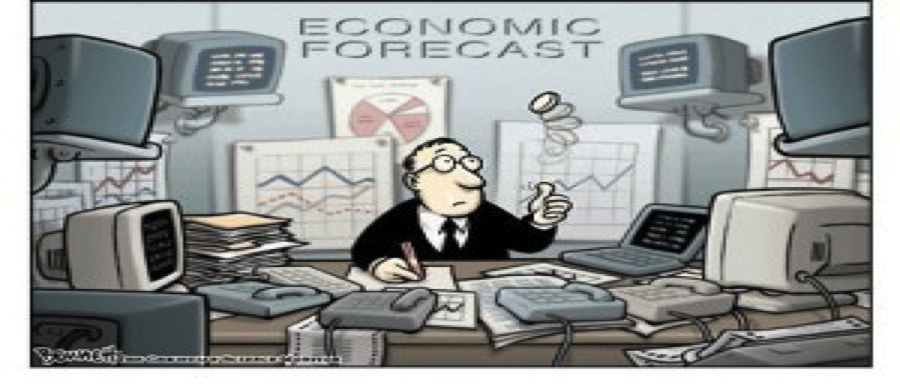Showing posts with label Forecasting Forum. Show all posts
Saturday, April 8, 2017
Workshop on Forecasting Issues in Developing Economies
Forecasting Issues in Developing Economies
April 26-27, 2017, Washington, DC
Wednesday, April 26
8.45-9.30 Registration and Breakfast
9.30-9.45 Opening Remarks: Tao Zhang, Deputy Managing Director, IMF
9.45-10.15 Session 1: Forecasting Turning Points
Chair: Prakash Loungani, Research Department, IMF
David Kuenzel, Wesleyan University
Chris Papageorgiou, Research Department, IMF
IMF Forecasts in Time of Crisis (Paper and Presentation)
(with Charis Christofides and Theo Eicher)
Discussant: Herman Stekler, George Washington University
10.15-11.15 Session 2: Energy and Climate Change
Chair: Gail Cohen, National Academies of Sciences, Engineering & Medicine
Jevgenijs Steinbuks, The World Bank
Assessing the Accuracy of Electricity Demand Forecasts in Developing Countries (Paper and Presentation)
Xinye Zheng, Renmin University of China
Economic Structure and Energy Consumption: Implications for 2030 Chinese Energy Demand (Paper and Presentation)
(with Fanghua Li and Li Zhang)
Discussant: Fred Joutz, George Washington University
11.15-11.30 Coffee Break
11.30-12.30 Session 3: Dealing with Uncertainty
Chair: Min Wei, Federal Reserve Board
Xuguang Simon Sheng, American University
The Measurement and Transmission of Macroeconomic Uncertainty: Evidence from the U.S. and BRIC Countries (Paper and Presentation)
(with Yang Liu)
Svetlana Makarova, University College London
Quasi Ex-Ante Inflation Forecast Uncertainty (Paper and Presentation)
(with Wojciech Charemza and Carlos Diaz)
Discussant: Sangyup (Sam) Choi, Mideastern & C. Asia Dept., IMF
12.30-2.00 Lunch
2.00-3.00 Session 4: Issues in Macroeconomics and Empirical Finance
Chair: Kirstin Hubrich, Federal Reserve Board
Speaker: Jonathan Wright, Johns Hopkins University
Ten Thoughts for Forecasting and Policy (Presentation)
Gloria Gonzalez-Rivera, University of California, Riverside
A Bootstrap Approach for Generalized Autocontour Testing. Implications for VIX Forecast Densities (Paper and Presentation)
(with J.H. Mazzeu, E. Ruiz, and H. Veiga)
3.00-3.30 Session 5: Financial Forecasting
Chair: Rita Biswas, University at Albany – SUNY
Sophia Chen, Research Department, IMF
Financial Information and Macroeconomic Forecasts (Paper and Presentation)
(with Romain Ranciere)
Discussant: Zhaogang Song, Johns Hopkins University
3.30-3.45 Group Photo
3.45-4.00 Coffee Break
4.00-5.15 Session 6: Frontiers of Forecasting
Chair: Herman Stekler, George Washington University
Keynotes:
Frank Diebold, University of Pennsylvania
Econometrics, Predictive Modeling, Causal Estimation, and Machine Learning
Kajal Lahiri, University at Albany – SUNY
The International Transmission of Shocks. A Factor Structural Analysis Using Forecast Data (Presentation)
7.00 Workshop Dinner
Taberna del Alabardero (1776 I St., NW; entrance on 18th Street)
Thursday, April 27
9.00-9.30 Breakfast
9.30-10.30 Session 7: Unemployment and Growth Forecasts
Chair: Milt Marquis, Florida State University
Neil Ericsson, Federal Reserve Board
Detecting Time-dependent Bias in the Fed’s Greenbook Forecasts (Paper)
(with Emilio Fiallos and J E. Seymour)
Laurence Ball, Johns Hopkins University
An Assessment of IMF Unemployment Forecasts for Advanced and Developing Economies (Paper and Presentation)
(with Zidong An, Joao Jalles and Prakash Loungani)
Discussant: Gabe Mathy, American University
10.30-10.45 Coffee Break
10.45-11.45 Session 8: Inflation and Monetary Policy
Chair: Subir Gokarn, Office of Executive Directors, IMF
Abhiman Das, Indian Institute of Management
Herbert Zhao, Towson University
Asymmetries in Indian Inflation Expectations: A Study Using IESH Quantitative Survey Data (Paper and Presentation)
(with Kajal Lahiri)
Roberto Duncan, Ohio University
New Perspectives on Forecasting Inflation in Emerging Economies: An Empirical Assessment (Paper and Presentation)
(with Enrique Martinez-Garcia)
Discussant: Tara Sinclair, George Washington University
11.45-12.30 Session 9: Economic Prospects for Africa
Chair: Maxwell Opoku-Afari, African Department, IMF
Speakers:Anthony Simpasa, African Development Bank
Intelligent Forecasting of Economic Growth for African Economies: Artificial Neural Networks versus Time Series and Structural Econometric Models (Paper and Presentation)
(with Chuku Chuku and Jacob Oduor)
Discussant: Khaled Hussein, UN Economic Commission for Africa
Forecasting Issues in Developing Economies
April 26-27, 2017, Washington, DC

Wednesday, April 26
8.45-9.30 Registration and Breakfast
9.30-9.45 Opening Remarks: Tao Zhang, Deputy Managing Director, IMF
9.45-10.15 Session 1: Forecasting Turning Points
Chair: Prakash Loungani, Research Department, IMF
David Kuenzel, Wesleyan University
Chris Papageorgiou, Research Department, IMF
IMF Forecasts in Time of Crisis (Paper and Presentation)
(with Charis Christofides and Theo Eicher)
Discussant: Herman Stekler,
Posted by at 5:11 PM
Labels: Forecasting Forum
Monday, March 20, 2017
Inflation-Forecast Targeting for India
A new IMF working paper studies the Inflation-Forecast Targeting in India. “India formally adopted flexible-inflation targeting (FIT) in June 2016 to place price stability, defined in terms of a target CPI inflation, as the primary objective of the monetary policy. In this context, the paper draws on Indian macro-economic developments since 2000 and the experience of other countries that adopted FIT to bring out insights on how credible policy with an emphasis on strong nominal anchor can reduce the impact of supply shocks and improve macroeconomic stability. For illustrating the key issues given the unique structural characteristics of India and the policy options under an FIT framework, the paper describes an analytical framework using the core Quarterly Projection Model (QPM). Simulation of QPM are carried out to illustrate the monetary policy responses under different types of uncertainty and to bring out the importance of gaining credibility for improving monetary policy efficacy.”

A new IMF working paper studies the Inflation-Forecast Targeting in India. “India formally adopted flexible-inflation targeting (FIT) in June 2016 to place price stability, defined in terms of a target CPI inflation, as the primary objective of the monetary policy. In this context, the paper draws on Indian macro-economic developments since 2000 and the experience of other countries that adopted FIT to bring out insights on how credible policy with an emphasis on strong nominal anchor can reduce the impact of supply shocks and improve macroeconomic stability.
Posted by at 11:12 AM
Labels: Forecasting Forum
Thursday, February 2, 2017
Groundhog Day Tradition: 2017 Stekler Award for Courage in Forecasting
This year’s award is shared by Allan Lichtman and Helmut Norpoth, two political scientists, who forecasted a Trump victory in the U.S. Presidential elections. Though I started out giving the award to people who had the courage to forecast recessions, I think it is good to broaden it to recognize courageous forecasts in other areas. Both Lichtman and Norpoth described the basis on which they were making their forecasts, which is an essential consideration in who gets the award. Outrageous forecasts made without providing some reasoning don’t qualify. The 2016 award went to Michael Shedlock (“Mish”) and the inaugural 2015 award to Lakshman Achuthan.
This year’s award is shared by Allan Lichtman and Helmut Norpoth, two political scientists, who forecasted a Trump victory in the U.S. Presidential elections. Though I started out giving the award to people who had the courage to forecast recessions, I think it is good to broaden it to recognize courageous forecasts in other areas. Both Lichtman and Norpoth described the basis on which they were making their forecasts, which is an essential consideration in who gets the award.
Posted by at 9:00 AM
Labels: Forecasting Forum
Monday, January 16, 2017
IMF WEO Forecasts: A Shifting Economic Landscape
The latest World Economic Outlook (WEO) Update says that: “After a lackluster outturn in 2016, economic activity is projected to pick up pace in 2017 and 2018, especially in emerging market and developing economies. However, there is a wide dispersion of possible outcomes around the projections, given uncertainty surrounding the policy stance of the incoming U.S. administration and its global ramifications. The assumptions underpinning the forecast should be more specific by the time of the April 2017 World Economic Outlook, as more clarity emerges on U.S. policies and their implications for the global economy.”
Continue reading here.
The latest World Economic Outlook (WEO) Update says that: “After a lackluster outturn in 2016, economic activity is projected to pick up pace in 2017 and 2018, especially in emerging market and developing economies. However, there is a wide dispersion of possible outcomes around the projections, given uncertainty surrounding the policy stance of the incoming U.S. administration and its global ramifications. The assumptions underpinning the forecast should be more specific by the time of the April 2017 World Economic Outlook,
Posted by at 8:50 PM
Labels: Forecasting Forum
Monday, January 9, 2017
Three Economists Walk into a Bar: Ouch! (The Perils of Forecasting)
James Mackintosh in the Wall Street Journal says “economics is hopeless at predicting big turning points in the economy, precisely the moments you most want advance warning. Studies by Prakash Loungani, chief of development economics in the International Monetary Fund’s research department, and collaborators have shown the failure to forecast recessions. Not one of the 62 recessions in 2008 and 2009 worldwide was predicted by the average collected by Consensus Economics by September of the year before. For the U.S., the economy’s only ever been forecast to shrink after a recession has already begun. “I’m a bit puzzled as to why so much attention is given to the point estimates for forecasts,” Mr Loungani says.”
“Investors might be tempted to consign economics to the joke book and get on with their lives. That would be a mistake. Economics can be useful, but only when used correctly to assess different scenarios. Specific forecasts for the economy must come with probabilities and clear assumptions–and the assumptions need to be critically examined by users of the forecasts, not hidden in the models or the appendix.”
Continue reading here.
James Mackintosh in the Wall Street Journal says “economics is hopeless at predicting big turning points in the economy, precisely the moments you most want advance warning. Studies by Prakash Loungani, chief of development economics in the International Monetary Fund’s research department, and collaborators have shown the failure to forecast recessions. Not one of the 62 recessions in 2008 and 2009 worldwide was predicted by the average collected by Consensus Economics by September of the year before.
Posted by at 11:39 PM
Labels: Forecasting Forum
Subscribe to: Posts



